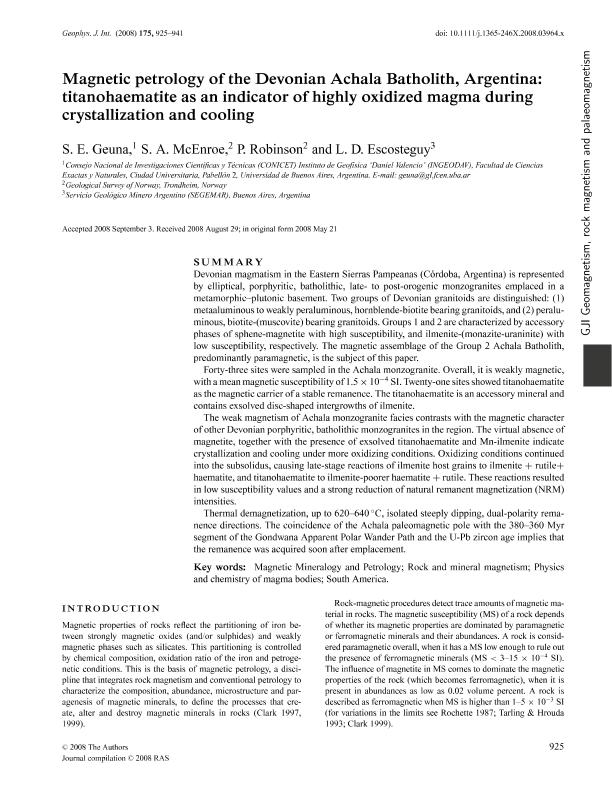Artículo
Magnetic petrology of the Devonian Achala Batholith, Argentina: Titanohaematite as an indicator of highly oxidized magma during crystallization and cooling
Fecha de publicación:
12/2008
Editorial:
Wiley Blackwell Publishing, Inc
Revista:
Geophysical Journal International
ISSN:
0956-540X
Idioma:
Inglés
Tipo de recurso:
Artículo publicado
Clasificación temática:
Resumen
Devonian magmatism in the Eastern Sierras Pampeanas (Córdoba, Argentina) is represented by elliptical, porphyritic, batholithic, late- to post-orogenic monzogranites emplaced in a metamorphic-plutonic basement. Two groups of Devonian granitoids are distinguished: (1) metaaluminous to weakly peraluminous, hornblende-biotite bearing granitoids, and (2) peraluminous, biotite-(muscovite) bearing granitoids. Groups 1 and 2 are characterized by accessory phases of sphene-magnetite with high susceptibility, and ilmenite-(monazite-uraninite) with low susceptibility, respectively. The magnetic assemblage of the Group 2 Achala Batholith, predominantly paramagnetic, is the subject of this paper Forty-three sites were sampled in the Achala monzogranite. Overall, it is weakly magnetic, with a mean magnetic susceptibility of 1.5 × 10 -4 SI. Twenty-one sites showed titanohaematite as the magnetic carrier of a stable remanence. The titanohaematite is an accessory mineral and contains exsolved disc-shaped intergrowths of ilmenite. The weak magnetism of Achala monzogranite facies contrasts with the magnetic character of other Devonian porphyritic, batholithic monzogranites in the region. The virtual absence of magnetite, together with the presence of exsolved titanohaematite and Mn-ilmenite indicate crystallization and cooling under more oxidizing conditions. Oxidizing conditions continued into the subsolidus, causing late-stage reactions of ilmenite host grains to ilmenite + rutile+ haematite, and titanohaematite to ilmenite-poorer haematite + rutile. These reactions resulted in low susceptibility values and a strong reduction of natural remanent magnetization (NRM) intensities. Thermal demagnetization, up to 620-640°C, isolated steeply dipping, dual-polarity remanence directions. The coincidence of the Achala paleomagnetic pole with the 380-360 Myr segment of the Gondwana Apparent Polar Wander Path and the U-Pb zircon age implies that the remanence was acquired soon after emplacement.
Archivos asociados
Licencia
Identificadores
Colecciones
Articulos(IGEBA)
Articulos de INSTITUTO DE GEOCIENCIAS BASICAS, APLICADAS Y AMBIENTALES DE BS. AS
Articulos de INSTITUTO DE GEOCIENCIAS BASICAS, APLICADAS Y AMBIENTALES DE BS. AS
Citación
Geuna, Silvana Evangelina; Mcenroe, S. A.; Robinson, P.; Escosteguy, Leonardo Darío; Magnetic petrology of the Devonian Achala Batholith, Argentina: Titanohaematite as an indicator of highly oxidized magma during crystallization and cooling; Wiley Blackwell Publishing, Inc; Geophysical Journal International; 175; 3; 12-2008; 925-941
Compartir
Altmétricas




